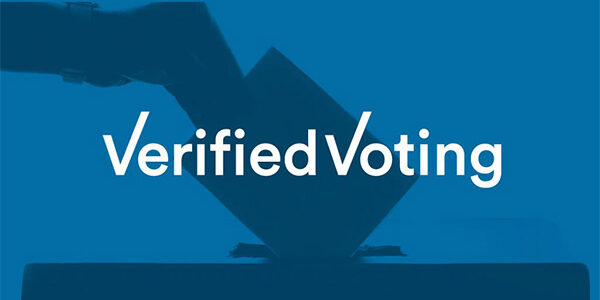March 22, 2023
The Honorable John Boozman
U.S. Senate
555 Dirksen Senate Office Building
Washington, D.C. 20510
The Honorable Christopher Coons
U.S. Senate
218 Russell Senate Office Building
Washington, D.C. 20510
The Honorable Dick Durbin
U.S. Senate
711 Hart Senate Office Building
Washington, D.C. 2051
The Honorable Bill Hagerty
U.S. Senate
248 Russell Senate Office Building
Washington, D.C. 20002
The Honorable Martin Heinrich
U.S. Senate
303 Hart Senate Office Building
Washington, D.C. 20510
The Honorable Chris Van Hollen
U.S. Senate
730 Hart Senate Office Building
Washington, D.C. 20510
The Honorable John Kennedy
U.S. Senate
437 Russell Senate Office Building
Washington, D.C. 20510
The Honorable Joe Manchin
U.S. Senate
306 Hart Senate Office Building
Washington, D.C. 20510
The Honorable Marco Rubio
U.S. Senate
284 Russell Senate Office Building
Washington, D.C. 20510
Re: Bipartisan Call to Fund Local Election Departments
Dear Senators,
Verified Voting is a nonpartisan nonprofit organization whose mission is to strengthen democracy for all voters by promoting the responsible use of technology in elections. We believe that the integrity and strength of our democracy rely on citizens’ trust that each vote is counted as cast. In a time when the public scrutiny of elections is higher than ever, Congress must act to support election officials, safeguard our elections infrastructure, and give voters justified confidence in election outcomes by providing consistent, adequate funding to meet the full need of elections offices.
We request that you submit a programmatic budget request for $400 million in Help America Vote Act (HAVA) Security Grants in the FY2024 Subcommittee on Financial Services and General Government (FSGG) bill to the Senate Appropriations Committee and FSGG Subcommittee leadership. This critical funding will support much-needed repairs and improvements to our nation’s critical election infrastructure. We advocate for this funding to be allocated with two-thirds of the funds sent directly to local election offices, where the need is greatest and best informed by local conditions, with one-third sent to state election officials to address statewide needs.
While the 2022 midterm elections were successfully and securely administered, local election officials across the country continue to face resource constraints that make their jobs more difficult. Local and state elections officials face increased challenges to running elections, from continued foreign security threats and rising insider security threats,[1] to the growing stock of aging election equipment.[2] Years of unmet infrastructure needs have led to challenges that directly affect voters, such as failing voting equipment, polling place closures, and cyber and physical security threats that weaken public trust. Election offices struggle to bear the price of basic necessities amidst higher labor costs and ballot paper supply shortages.[3] These challenges are not unique to any single jurisdiction—they harm rural communities and urban communities in big and small states alike.
Currently, the voting equipment used by most in-person voters in jurisdictions in 21 states is no longer manufactured, making it difficult or impossible for election officials to acquire replacement parts.[4] Further, in jurisdictions in 20 states and two territories, voters who need assistive voting equipment to vote privately and independently must use equipment that is no longer manufactured.[5] Finally, jurisdictions in eighteen states continue to use mail ballot tabulation equipment that is no longer manufactured, again making equipment breakdowns difficult or impossible to repair.[6] As the 2024 election cycle approaches, greater investment from the federal government would allow these jurisdictions to make needed upgrades and replacements.
Federal elections are the costliest for local election officials to administer, due in part to their higher turnout and longer ballots, yet federal funding for election infrastructure has remained flat and minimal over successive federal budgets. The most recent budget allocation amounted to less than 30 cents per person of voting age.[7] Elections offices need the federal government to pay its fair share of the cost of administering federal elections.
We understand that there are competing fiscal priorities, but this need cannot be ignored. Public confidence in our elections—and our democracy—remains at a tipping point. As we look to the 2024 presidential election, we ask Congress to listen to local election officials,[8] rather than replicate a budget that has failed to meet local needs. The federal government should adequately and responsibly invest in local election infrastructure in order to ensure efficient, safe, and fair federal elections.
Verified Voting is committed to supporting these efforts and looks forward to working with members of Congress to ensure secure, transparent, and accurate elections.
Sincerely,
Pamela Smith
President & CEO
Verified Voting
[1] See, e.g., Alexandra Kelley, CISA: Election Security Still Under Threat at Cyber and Physical Level, Nextgov (Mar. 20, 2023) https://www.nextgov.com/cybersecurity/2023/03/cisa-election-security-still-under-threat-cyber-and-physical-level/384172/.
[2] Turquoise Baker et al., Voting Machines at Risk in 2022, Brennan Center for Justice (Mar. 1, 2022) https://www.brennancenter.org/our-work/research-reports/voting-machines-risk-2022; see also The Verifier — First Year in Use — November 2024, Verified Voting, https://verifiedvoting.org/verifier/#mode/navigate/map/fieldedEquip/mapType/ppEquip/year/2024 (last visited Mar. 21, 2023).
[3] See Lawrence Norden & Andrea Córdova McCadney, Voting Machines at Risk: Where We Stand Today, Brennan Center for Justice (Mar. 5, 2019), https://www.brennancenter.org/our-work/research-reports/voting-machines-risk-where-we-stand-today.
[4] See Verified Voting, supra note 2.
[5] See id.
[6] See id.
[7] See Estimates of the Voting Age Population for 2021, 87 Fed. Reg. 18354 (Mar. 30, 2022). The voting age population in the 50 states plus D.C. was estimated at 258,327,312 in 2021.
[8] See, e.g., 2020 Election Funding Helped Fill Gaps in Election Infrastructure, Center for Tech and Civic Life (Sept. 28, 2021), https://www.techandciviclife.org/election-infrastructure-2020-funding/.
